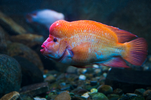
American Cichlids: Colour, Chaos, and Character in Glass
, by Majella Gee, 26 min reading time

, by Majella Gee, 26 min reading time
If you’ve ever stood in front of a tank of cichlids and thought, “Wow, they’re stunning!”, you’re right. If your second thought was, “I bet they’d look amazing in my tank,” — slow down, cowboy.
American cichlids aren’t your average community fish. They’re feisty, full of personality, and can be either your greatest joy or your biggest headache, depending on how you set them up.
Let’s dive deep into the world of these aquatic heavyweights — their habits, homes, and the fine art of keeping them from tearing each other to shreds.

Meet the Americans
“American cichlid” covers a wide family of species native to Central and South America, including some of the hobby’s most popular (and temperamental) fish.
Common Central & South American Species
Each one has its quirks. Oscars recognise their owners and might even beg for food. Convicts will remodel your tank daily. Discus demand spa-like conditions and freak out if you skip maintenance.
So before you buy, match your fish to your lifestyle, not your Instagram feed.
Tank Size: Bigger Is Always Better
A single Oscar needs at least a 200L tank, and that’s the bare minimum. A breeding pair of Convicts? 100L or more — but don’t expect tankmates to survive when they’re spawning.
Rule of thumb:
Cichlids are territorial. Think of them as the rowdy neighbours who need their own yards. If space is tight, fights are inevitable.

Water Quality & Chemistry
This is where most new keepers slip up. American cichlids prefer softer, slightly acidic water compared to their African cousins.
They hate sudden swings. Invest in a good heater, thermometer, and water test kit — not the bargain-bin stuff.
If your tap water is too hard (common in parts of Australia), mix with RO or rainwater — but always stabilise and condition before adding it to the tank.
Clean water is life. 20–30% weekly water changes are non-negotiable.

Feeding the Beasts
These fish are carnivorous or omnivorous, depending on species, but all need high-protein, natural foods to thrive. Skip the cheap flakes — they cloud water and offer little nutrition.
Recommended Natural Foods (Readily Available in Australia)
Species-Specific Feeding Tips
Avoid feeding red meat, chicken, or oily fish. It causes fatty liver disease and pollutes the water.
And please — don’t overfeed. Cichlids will eat like Labradors, but that doesn’t mean they should.

Tank Setup & Décor: The Art of Controlled Chaos
Cichlids are natural diggers and decorators. They’ll shovel gravel, move rocks, and uproot plants like they’re running a renovation show.
To keep your tank (and sanity) intact:
They love creating caves and territories, so build multiple hiding spots. If they all claim one, you’ll need to rearrange (again).
Tankmates: Friends or Foes?
Ah, the eternal question — what can live with cichlids?
Short answer: not much, unless you know your species and personalities.
Generally Compatible (with caution):
Avoid:
If breeding behaviour kicks in, even your “peaceful” pair might turn into miniature monsters overnight.

Breeding: Romance with a Side of Mayhem
Most American cichlids are egg layers and devoted parents, which sounds sweet until you realise “devoted” means they’ll attack anything — including your hand — to protect the fry.
When they pair up, expect aggression. If you’re not planning on breeding, keep just one or ensure you’ve got enough room to separate them.
Oh, and those cute baby fish? You’ll have hundreds. Plan ahead or find a store willing to take fry off your hands.

Common Problems
Most issues stem from neglect, overfeeding, or overcrowding — all human errors.
Maintenance Routine
Consistency keeps your tank thriving:
Think of it as running a tiny aquatic city. Ignore the infrastructure, and chaos follows.

Final Thoughts: Big Fish, Big Commitment
Keeping American cichlids isn’t for the faint-hearted. They’re not “set and forget” fish — they’re interactive, intelligent, and often unpredictable.
But if you’re up for it, they’ll reward you with vibrant colour, fascinating behaviour, and years of companionship.
Respect their needs, feed them well, and give them space to rule their watery kingdoms — and you’ll never look at “normal” fish the same way again.
If you love the fire and flair of American Cichlids, don’t miss their colourful cousins —
👉 African Cichlids: The Rock Dwellers of the Rift Lakes — a deep dive into their wild, rocky world and the dramatic personalities that come with it.
©Majella Gee 2025
Images
Main image: Red Devil (Amphilophus labiatus)
Top to bottom: Angel Fish (Pterophyllum scalare), Oscar (Astronotus ocellatus), Convict (Amatitlania nigrofasciata), Jack Dempsey (Rocio octofasciata), Albino Convict with eggs, Breeding pair of Firemouth Cichlids (Thorichthys meeki) and a Turquoise Discus.
AmericanCichlids #CichlidTank #OscarFish #DiscusFish #AngelfishLove #Aquascaping #FishKeeping #AquariumLife #TropicalFishAustralia #CichlidLovers #NaturalAquarium #MajellasPetStore #HealthyAquarium #FishCare #AquariumTips